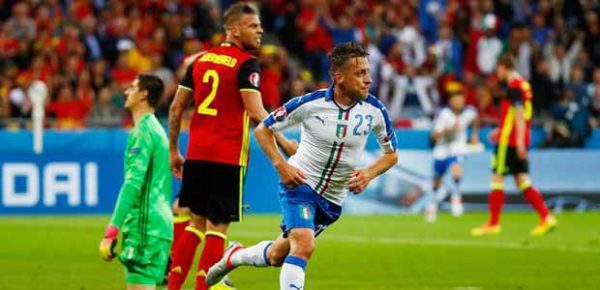Jan Vertonghen and Toby Alderweireld couldn’t stop their side playing in to the hands of the Azzuri as it finished Belgium 0-2 Italy in Lyon.
Antonio Conte may not have had the star names, but his highly organised side nullified Marc Wilmots team as it finished Belgium 0-2 Italy in Lyon. They played open with the ball, were committed to attacking with their twin striker approach and always gave the man in possession plenty of options.
Italy set up drags Belgium in opposite directions
Antonio Conte has built much of his reputation on three at the back with Juventus. Installing his former charges of Georgio Chiellini, Andrea Barzagli and Leonardo Bonucci ahead of Gianluigi Buffon, he built a firm base for the rest of his team to operate.
Ahead of the ball playing Bonucci, Conte had his side pull Belgium in opposite directions. Danielle De Rossi would drop in whilst Emanuele Giaccherini and Marco Parolo would pull apart. This split Radja Nainggolan and Axel Witsel at the base of the Belgium midfield. In the space created by pulling Witsel and Nainggolan apart, Graziano Pelle would come short to drag the defence up and Eder would try and run in-behind.
Out on the flanks and wingbacks Matteo Darmian and Antonio Candreva would push on as high as possible to drag out the Belgian full backs. This created the space to leave the centre backs 2v2 with Pelle and Eder.
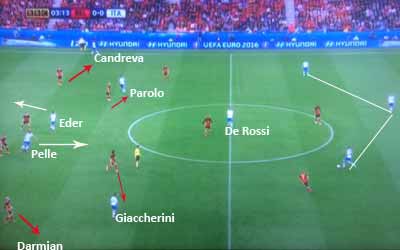
It all proved tough for Belgium to get to grips with. Italy weren’t afraid to play with the ball, moving it around at the back with their extra numbers in central defence, but also using the back three to spray it out to the wingbacks. Candreva and Darmian were flying up and down the touchline as they sought to create crossing opportunities, but to also open the inside channels for Giaccherini and Parolo by dragging the Belgian full backs out. The system was a master class of how to pull the opposition in different directions, whilst also giving the man on the ball options.
Belgium’s struggles
Belgium weren’t doing themselves any favours. They were often content to give Italy the ball at the back. Romelu Lukaku was offering token resistance, but was just being navigated around by Italy’s back three. Kevin de Bruyne or Eden Hazard in the wide midfield positions didn’t help Lukaku, as they were often hesitant to get sucked up field. Marouane Fellaini, who was selected as the number ten, but he couldn’t help as he was regularly shadowing Danielle De Rossi.
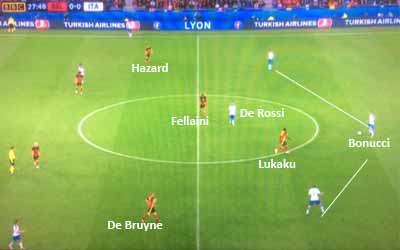
It meant that Italy often had time and space to pick their option and play the pass. Either a ball up in to Graziano Pelle coming short or out to a wingback pushing on high.
When Belgium did have the ball, their setup wasn’t helping them. In selecting Lukaku upfront and Fellaini as number ten, they were looking to get the ball quickly in to them and then off to de Bruyne and Hazard, along with the full backs, to supply crosses in to the box.
Belgium attempted 27 crosses from open play in the match, but rarely found their targets. The reason for this was that Fellaini wasn’t quick or mobile enough to get forward in to the box after being involved in the build-up. This often left Lukaku as the sole man for them to look for up against three Italian centre backs, where he didn’t stand much of a chance. Lukaku was regularly the only target in the area and even when Fellaini did get up and join him, it only created two shots for Nainggolan from just outside the area.
Belgium also struggled with Italy’s compact shape without the ball. The Italians were playing with a very short distance from back to front when they could get their defence set. They were tempting Belgium to try the ball in-behind as they backed their well-marshalled defence to cope. They would squeeze up and drop as pressure was eased off or applied to the ball like a well-oiled machine.
Rather than take the challenge on and look for the early ball to Lukaku over the top, Belgium tried to play through and were often thwarted.
When Belgium did look to break quickly they had two great opportunities. Lukaku made a hash of the first one as he ran outside, increasing the number of defenders between him and Kevin De Bruyne. On the second de Bruyne found him, but Lukaku couldn’t find a finish.
Italy takes the lead
With Italy pulling Belgium in different directions, both across and up and down the pitch, it was only apt that they took the lead from doing just this.
Belgium were struggling and when Leonardo Bonucci picked up the ball were in a mess defensively. Lukaku had given up trying to close the centre backs down on his own. Fellaini was drawn to his man-marking job on De Rossi. Witsel, who was being pulled towards the touchline by Parolo, had left him. Nainggolan, who was being dragged towards the other touchline by Giaccherini, was pointing at someone to pick up his man. This caused Toby Alderweireld to be drawn out by Eder coming short to partially hesitate, which was fatal.
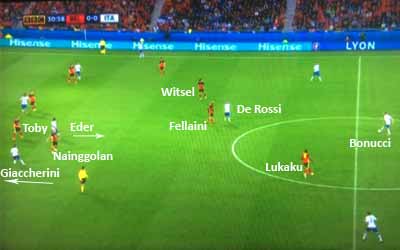
With no pressure on the ball or him, Bonucci lifted an exquisite pass that Toby Alderweireld would’ve been proud of, over the Belgian’s head in to Giaccherini’s path. It was the culmination of 32 minutes of fine work.
Substitutions
Belgium’s attack was sputtering until Dries Mertens entered the game for Radja Nainggolan. This moved Marouane Fellaini back in to the pivot alongside Axel Witsel and gave Belgium a better attacking base. With three ball players in the attacking midfield trio, Belgium could now work more of the positions they wanted.
The removal of Romelu Lukaku for Divock Origi then gave them the threat of someone that would look to run in-behind the Italian defence, but also a factor on crosses.
Unlike the first half, the Belgians now flooded the box for their crosses and Origi had two great chances, both created by Kevin de Bruyne.
The first saw Origi flick de Bruyne’s diagonal ball in from the left just over the bar. The second saw de Bruyne pop up on the right this time and curl in a sumptuous cross. Origi rose unmarked and with the goal at his mercy missed it completely as he twisted his head to try and get a more powerful contact. It then came through unexpectedly to Fellaini who couldn’t control the ball getting to him so quickly and the chance was gone.
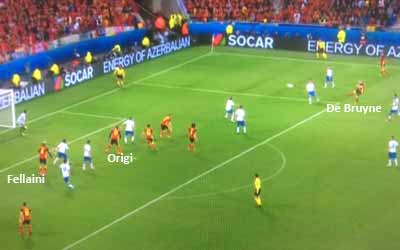
Italy wraps up the points
Belgium were pushing for an equaliser and committing men forward, Fellaini from the base of midfield especially. Recognising this, Antonio Conte sent on a sub of his own to try and profit. Ciro Immobile came on for Eder and his bursts forward on the counter attack were full of menace.
One of his first actions was to jet forward and force a stretching save from Thibault Courtois as his shot was heading for the top corner.
Immobile was then involved in the goal that sealed the game. Dries Mertens turned possession over and after moving it around their back three, which pulled a number of Belgian players out of position, Immobile received the ball. He raced forward in to space, which committed the Belgian centre backs towards him, and Italy now had men over.
Antonio Candreva, who’s lung bursting runs up and down the line had given Belgium trouble all night, received the pass in space towards the flank once again. Candreva had chipped a cross in 20 minutes earlier from the exact same position. Graziano Pelle, who had forced a sprawling save from Courtois with a header that time, unleashed an unstoppable volley this. Neither Courtois nor his defenders could stop it and the Azzuri were in wonderland with the score now Belgium 0-2 Italy.
Belgium 0-2 Italy overall
This was a victory for a unit playing in sync against a team relying on individuals to make the difference. Belgium really struggled to get to grips with Italy’s setup and tactics, which pulled them all over the park.
Italy’s play was impressive as they were very open and attacking with the ball. The wingbacks were extremely high up and the formation often looked like a 3-1-4-2 at times.
The man on the ball always had options due to the different movements in the team. Players stretching Belgium towards the touchlines whilst others moved up and down the pitch to offer both short and in-behind runs.
When they lost it their defensive structure was compact and solid. There were moments when they were unbalanced and prone to counter attacks, but given a moment to regroup and regain their shape, they were tough to break down.
Jan Vertonghen and Toby Alderweireld performance
Without a number of defensive players, you couldn’t help but wonder why Marc Wilmots didn’t partner Jan Vertonghen and Toby Alderweireld at the heart of his defence?
Vertonghen, as he often does, looked like a player out of position when used as a left back. He struggles against tricky players with pace when out at full back and Antonio Candreva often had the best of him. Being drawn out towards the touchline by Candreva playing so wide and high up gave Vertonghen problems with no help or cover inside him. It also stopped him getting forward to help supply crosses or wing support to Eden Hazard.
Toby Alderweireld had an ok game, but Belgium didn’t take advantage of his range of passing. With Lukaku, nor anybody else for that matter, looking to run in-behind, Toby was restricted to short or square passes. It was eye-opening that Bonucci supplied a pass for Italy’s opener that Alderweireld often tries.
He and Vermaelen also looked on different wavelengths at times, not operating in tandem and getting caught by Pelle and Eder’s movement. They weren’t helped by Nainggolan and Witsel being dragged apart in-front of them, which left them often exposed, but they didn’t communicate well either.
You also wondered whether Mousa Dembele would’ve made a difference? Marouane Fellaini didn’t get to grips with his role and Belgium looked a far better team when he was moved deeper. Dembele’s strength and ball retention would’ve offered something else if he’d been alongside Witsel. His touch, control and passing could’ve also seen him used as a number ten, a position he has played well for Spurs in. There’s plenty for Marc Wilmots to ponder.
